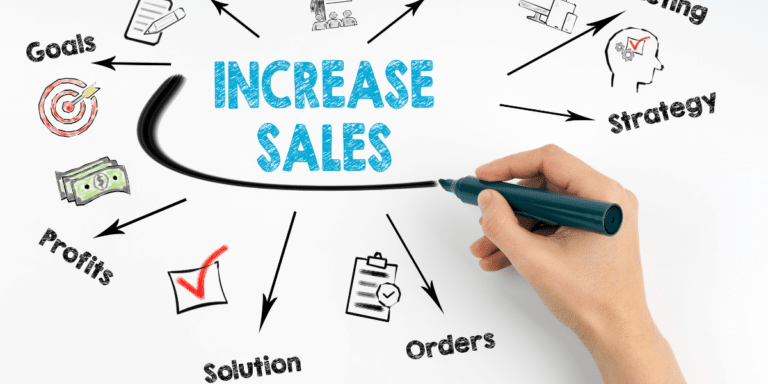 In the digital age, online sales have become a critical revenue stream for businesses of all sizes. However, increasing online sales requires more than just setting up a website. It involves implementing a range of best practices that optimize the customer experience, improve conversion rates, and boost revenue. In this article, we’ll explore proven strategies for increasing online sales, focusing on website optimization, digital marketing, customer engagement, and data-driven decision-making. Find out here how to increase sales online. Best practices by industry experts. For more help, work through retail marketing or business consulting services.
In the digital age, online sales have become a critical revenue stream for businesses of all sizes. However, increasing online sales requires more than just setting up a website. It involves implementing a range of best practices that optimize the customer experience, improve conversion rates, and boost revenue. In this article, we’ll explore proven strategies for increasing online sales, focusing on website optimization, digital marketing, customer engagement, and data-driven decision-making. Find out here how to increase sales online. Best practices by industry experts. For more help, work through retail marketing or business consulting services.
Optimizing Your Website for Sales
First and foremost, your website is the foundation of your online sales efforts. To maximize sales, your website must be optimized for both usability and conversion. Start by ensuring that your website is easy to navigate. Visitors should be able to find what they’re looking for quickly and easily. This means having a clear and logical structure, intuitive navigation menus, and a search function that works efficiently.
Moreover, mobile optimization is essential in today’s market. With more consumers shopping on their smartphones, your website must be fully responsive. This ensures that your site looks and functions well on all devices, whether it’s a desktop, tablet, or mobile phone. A mobile-friendly website not only improves the user experience but also boosts your search engine rankings, which can drive more traffic to your site.
Additionally, fast loading times are critical for keeping potential customers engaged. If your website takes too long to load, visitors are likely to leave before making a purchase. Therefore, optimizing your site’s speed is crucial. This can be achieved by compressing images, leveraging browser caching, and minimizing the use of heavy scripts. How to increase sales online includes a well optimized website. A faster website leads to a better user experience, which can significantly increase your conversion rates.
Leveraging Digital Marketing Strategies
Next, digital marketing plays a crucial role in driving online sales. To reach more potential customers, you need to implement a well-rounded digital marketing strategy. Start by focusing on Search Engine Optimization (SEO). By optimizing your website and content with relevant keywords, you can improve your search engine rankings. Higher rankings mean more visibility, which leads to increased traffic and, ultimately, more sales.
In addition to SEO, pay-per-click (PPC) advertising is another effective tool. PPC campaigns allow you to target specific demographics with tailored ads. Platforms like Google Ads and Facebook Ads offer robust targeting options, enabling you to reach your ideal customers. Moreover, PPC ads can drive immediate traffic to your website, providing quick results. However, it’s essential to monitor your campaigns closely to ensure you’re getting a good return on investment (ROI).
Furthermore, social media marketing is a powerful way to engage with potential customers and drive sales. Platforms like Instagram, Facebook, and Pinterest are particularly effective for promoting products and services. Regularly posting engaging content, such as product photos, videos, and customer testimonials, can keep your audience interested and encourage them to make a purchase. Additionally, social media platforms offer advertising options that allow you to target specific audiences based on their interests and behaviors.
Email marketing remains one of the most effective ways to increase online sales. Building and maintaining an email list allows you to reach out to potential and existing customers with personalized offers and promotions. Segmenting your email list based on customer behavior and preferences can lead to higher open rates and conversions. Furthermore, automated email campaigns, such as abandoned cart reminders and post-purchase follow-ups, can help recover lost sales and build customer loyalty.
Enhancing Customer Engagement and Experience
Beyond digital marketing, customer engagement is key to increasing online sales. A positive customer experience can lead to repeat purchases and word-of-mouth referrals. Start by offering exceptional customer service. Providing multiple channels for customer support, such as live chat, email, and phone support, ensures that customers can reach you easily if they have questions or concerns.
Moreover, personalization can significantly enhance the customer experience. Personalizing product recommendations based on a customer’s browsing history and previous purchases can increase the likelihood of a sale. Tools like AI-driven recommendation engines can analyze customer data and provide tailored suggestions in real-time. Personalized experiences make customers feel valued and understood, which can lead to higher conversion rates.
Additionally, offering incentives can encourage customers to complete their purchases. Discounts, free shipping, and limited-time offers are effective ways to boost sales. For instance, offering a discount code to first-time visitors can entice them to make their first purchase. Similarly, free shipping thresholds encourage customers to add more items to their cart to qualify for the offer. These incentives create a sense of urgency and value, prompting customers to buy now rather than later.
Furthermore, building trust with your customers is crucial. Displaying customer reviews and testimonials on your product pages can reassure potential buyers about the quality of your products. Additionally, having clear and transparent policies on shipping, returns, and refunds can increase customer confidence. Trust is a significant factor in online shopping decisions, and building it can lead to higher sales and customer loyalty.
Utilizing Data-Driven Decision Making
Finally, data-driven decision-making is essential for optimizing your online sales strategies. By analyzing data, you can gain valuable insights into customer behavior and preferences. Tools like Google Analytics, heatmaps, and conversion tracking can help you understand how visitors interact with your website. This information can be used to identify areas for improvement and to optimize your sales funnel.
For example, analyzing your website’s traffic sources can reveal which marketing channels are driving the most sales. If you find that a particular social media platform or ad campaign is performing well, you can allocate more resources to that channel. Conversely, if a channel is underperforming, you can adjust your strategy or reduce spending in that area.
Additionally, A/B testing is a powerful way to optimize your website and marketing efforts. By testing different versions of a webpage, email, or ad, you can determine which performs better. For instance, you might test two different product page layouts to see which one leads to more sales. A/B testing allows you to make data-driven decisions that enhance the effectiveness of your online sales strategies.
Moreover, customer feedback is invaluable for improving your online sales. Regularly collecting and analyzing customer feedback can provide insights into what’s working and what’s not. Whether it’s through surveys, reviews, or direct customer interactions, feedback helps you understand your customers’ needs and expectations. By addressing their concerns and making necessary adjustments, you can enhance the customer experience and increase sales.
Conclusion
In conclusion, increasing online sales requires a comprehensive approach that combines website optimization, digital marketing, customer engagement, and data-driven decision-making. By implementing these best practices, you can create a seamless and effective online shopping experience for your customers. As the digital landscape continues to evolve, staying agile and responsive to changes will ensure your sales strategies remain effective and drive long-term growth. That’s how to increase sales online. Best practices by industry experts. For more help, work through retail marketing or business consulting services.








